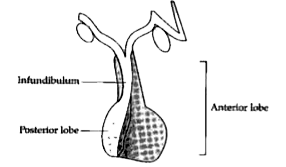Glands in a vertabrate body may originate from
ectoderm
mesoderm
ectoderm and endoderm
ectoderm, mesoderm and endoderm
The correct Answer is:D
Step-by-Step Solution:
1. Understanding Germ Layers:
- In vertebrates, during the early stages of embryonic development, the zygote undergoes several transformations, leading to the formation of three primary germ layers: ectoderm, mesoderm, and endoderm.
2. Identifying Gland Types:
- Glands can be classified into two main types based on their structure:
- Exocrine glands: These have ducts and secrete their products into these ducts (e.g., salivary glands).
- Endocrine glands: These are ductless and release their hormones directly into the bloodstream (e.g., thyroid gland).
3. Origin of Glands from Germ Layers:
- Each of the three germ layers contributes to the formation of different glands:
- Ectoderm: Gives rise to glands such as the pituitary and pineal glands.
- Endoderm: Forms glands like the pancreas and thyroid gland.
- Mesoderm: Contributes to glands such as the kidneys and gonads (ovaries and testes).
4. Conclusion:
- Since all three germ layers (ectoderm, mesoderm, and endoderm) can give rise to various glands in the vertebrate body, the correct answer is that glands may originate from all three layers.
5. Final Answer:
- The glands in a vertebrate body may originate from ectoderm, mesoderm, and endoderm. Therefore, the correct option is D (ectoderm, mesoderm, and endoderm).
- In vertebrates, during the early stages of embryonic development, the zygote undergoes several transformations, leading to the formation of three primary germ layers: ectoderm, mesoderm, and endoderm.
- Glands can be classified into two main types based on their structure:
- Exocrine glands: These have ducts and secrete their products into these ducts (e.g., salivary glands).
- Endocrine glands: These are ductless and release their hormones directly into the bloodstream (e.g., thyroid gland).
- Each of the three germ layers contributes to the formation of different glands:
- Ectoderm: Gives rise to glands such as the pituitary and pineal glands.
- Endoderm: Forms glands like the pancreas and thyroid gland.
- Mesoderm: Contributes to glands such as the kidneys and gonads (ovaries and testes).
- Since all three germ layers (ectoderm, mesoderm, and endoderm) can give rise to various glands in the vertebrate body, the correct answer is that glands may originate from all three layers.
- The glands in a vertebrate body may originate from ectoderm, mesoderm, and endoderm. Therefore, the correct option is D (ectoderm, mesoderm, and endoderm).
Topper's Solved these Questions
Similar Questions
Knowledge Check
- Question 1 - Select One
Tracheids of the primary plant body originate from the :
AprotodermBprocambiumCground meristemDxylem rays
All glands, whether exocrine or endocrine in a mammal, originate from epithelial tissues.
View SolutionSweat glands of human being originate from :-
View SolutionMuscles of Iris & Ciliary body originate :−
View SolutionWhich of the following are triploblastic, acoelomate with blind sac type of body plan, and parechyma cells originating from mesoderm fill up the cavities of the body ?
View SolutionPeritoneum and thyroid gland originate respectively from which germ layers?
View SolutionWhich of the following is considered a endocrine gland in the human body but is transiently formed
View SolutionThe diagram given below represents an endocrine gland in the Human body.

Explain the term Hormone.
What is the role of Tropic hormones in the human body?View Solution

